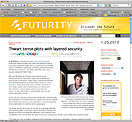News
UB part of new research Web site
-
 Print
Print -
 Comments
Comments
-

“We will continue to find new and innovative ways to tell the nation about our academic quality and the work of our faculty.”
UB has joined Stanford, Duke and other members of the Association of American Universities (AAU) in developing a Web site that delivers research news directly to the public. Futurity, which was launched in September, is designed to showcase the latest research discoveries in science, engineering, the environment, health and more.
According to Joe Brennan, associate vice president for university communications, Futurity was an idea developed by the AAU Public Affairs Network last year to create an online strategy for getting university research news in front of wider audiences in an era of shrinking traditional news media. UB’s Office of University Communications, which was involved at the development stage, is funding UB’s participation in this effort and supplying the stories, with the cooperation of UB’s research faculty.
UB’s research is being showcased alongside that of nearly 50 AAU schools, all among the top research institutions in the country. The front page of Futurity changes daily, with stories subsequently archived. Partnering universities contribute stories weekly.
The site has logged more than 250,000 visits in its first four months. A UB story, “A Generation Hooked on Caffeine,” holds the distinction of attracting the most number of hits in the site’s brief history—22,000 within the first week of its publication. The story tells of UB neurobiologist Jennifer Temple’s study of the effects of chronic caffeine consumption on young people. Click here to read the story in the UB Reporter.
“We’re having success on Futurity because of the quality of our faculty’s work and because they work with us to tell these stories to the nation,” says Brennan.
“This is a vehicle that can greatly advance UB’s reputation as a leading research university,” says John DellaContrada, senior director of media relations, explaining that the site also allows the public to see how federal and state funding are being put to use by universities to address critical challenges.
Stories include links to published research reports and supplemental materials that allow readers to explore topics in more detail. The site is available in a mobile-friendly version, and visitors can comment on stories and subscribe for daily e-mail updates.
DellaContrada notes that Futurity is one of the ways that University Communications has expanded its reach over the past several months. Social outlets like Twitter are being used to instantly update media on UB stories, and an expert’s blog called News Tips delivers to media commentary by UB faculty on news stories of the day.
It’s all part of the Web becoming the dominant medium of communications for UB and every university, says Brennan. “One of the things that is so attractive about Web-based communications is the ability to measure their effectiveness,” he says. “We will continue to find new and innovative ways to tell the nation about our academic quality and the work of our faculty.”

Reader Comments